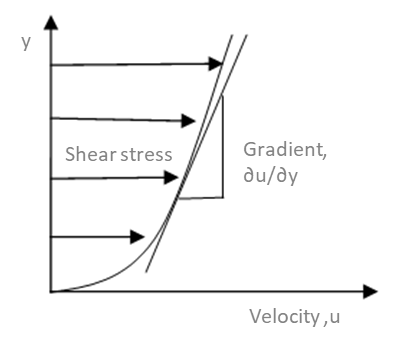
Dynamic Viscosity Formula: Viscosity, the resistance to motion exhibited by most fluids, arises when there is relative movement between fluid layers. It quantifies the hindrance to flow resulting from internal friction between these layers as they traverse one another during fluid motion. Alternatively, viscosity can be described as a measure of a fluid's thickness or its impeding nature for objects passing through.
Fluids with high viscosity impede motion due to robust intermolecular interactions, generating significant internal friction that hinders the movement of layers. In contrast, fluids with low viscosity flow effortlessly, as their molecular composition produces minimal friction during motion. While gases also possess viscosity, it is less perceptible in everyday experiences.
Dynamic Viscosity Definition
Viscosity, a measure of a fluid's resistance to flow, is calculated by determining the ratio of shearing stress to velocity gradient within the fluid.
This property is quantified in Poiseuille, an SI unit (PI), and can also be expressed in newton-second per square meter (N s m⁻²) or pascal-second (Pa s). The dimensional formula for viscosity is [ML⁻¹T⁻¹].
Liquids exhibit a rapid reduction in viscosity with increasing temperature, allowing them to flow more freely when heated. Conversely, gases experience an increase in viscosity with rising temperature, causing them to flow more slowly. Notably, viscosity remains an intensive property, remaining constant regardless of changes in the quantity of matter.
Formula for the Coefficient of Viscosity:
η= F⋅dx / A⋅dv
Where:
η is the coefficient of viscosity,
dx dv is the velocity gradient between two layers of liquid,
F is the viscous force, and A is the surface area.
Types of Viscosity
Dynamic Viscosity (Absolute Viscosity): This type of viscosity measures a fluid's resistance to flow when subjected to an applied force. It is referred to as Dynamic Viscosity. Kinematic Viscosity: This type of viscosity measures a fluid's resistance to flow under the influence of gravity. It is known as Kinematic viscosity.
It is common for people to conflate these two viscosity measurements, but they are distinct from each other. Kinematic viscosity proves more advantageous than absolute or dynamic viscosity in certain situations.
Dynamic Viscosity
Dynamic Viscosity measures a fluid's resistance to flow under the influence of an external force.

Understanding the viscosity of a fluid is essential for comprehending its behavior, especially when it interacts with solid boundaries and dictates its movement. Viscosity is a measure of a fluid's resistance to gradual deformation under tensile or shear stress, and the intermolecular friction between fluid layers attempting to slide over each other induces shear stress.
A valuable instrument for assessing dynamic viscosity is a rotational viscometer. In this device, probe within the liquid sample undergoes rotation. The force or torque needed to rotate the probe serves as the basis for viscosity determination.
Dynamic Viscosity Formula
The Dynamic Viscosity Formula for a fluid will specify its internal resistance to flow under the influence of a shearing force, a tangential force that arises when two horizontal planes come into contact. Viscosity, a crucial characteristic in the analysis of liquid behavior and fluid motion near solid boundaries, reflects the force needed for a fluid to overcome internal molecular friction and facilitate its flow.
Dynamic viscosity can be defined as the tangential force per unit area required to move a fluid in one horizontal plane relative to another at a velocity of unit value, with the fluid's molecules maintaining a unit distance apart.
Expressed as:
Dynamic viscosity (η)= T / γ
where: η is the Dynamic Viscosity, T is the shearing stress, and γ is the shear rate.
The SI unit for Dynamic Viscosity is either expressed as Pa·s or Ns/m².
Dynamic Viscosity Formula Solved Example
Example 1: A fluid experiences a shearing stress of 0.45 N per m² with a shear rate of 0.8 per second. Determine which fluid from the given options (Water dynamic viscosity = 1 Pa s, Air dynamic viscosity = 0.018 Pa s, and Mercury dynamic viscosity = 1.526 Pa s) corresponds to its dynamic viscosity.
Solution: Given: T=0.45N per m² γ=0.8per second
Using the formula: η= T /γ
= 0.45 /0.8
= 0.5625 Pa s
=0.5625Pa s
Comparing this dynamic viscosity with the given options, it is evident that the fluid corresponds to the viscosity of Air.
Explore Now Online Course of Class 9 Neev Fastrack 2024 and Class 10 Udaan Fastrack 2024 to enhance your Physics knowledge. and build a strong foundation.
| Related Links | |
| Angular Speed Formula | Mechanical Advantage Formula |
| Brownian Motion Formula | Intensity Formula |
Dynamic Viscosity Formula FAQs
What is the Dynamic Viscosity Formula?
How is Dynamic Viscosity Measured?
What are the SI Units for Dynamic Viscosity?
How does Dynamic Viscosity Relate to a Fluid's Behavior?










